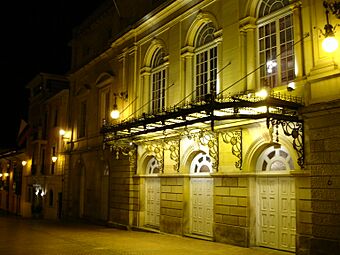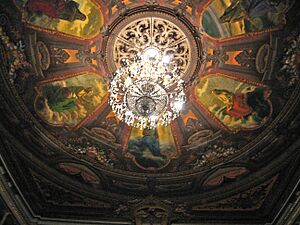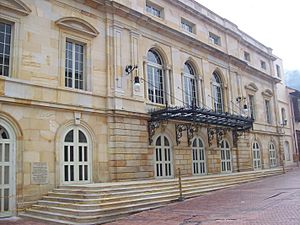Teatro de Cristóbal Colón facts for kids
|
Teatro de Cristóbal Colón
|
|

Facade of the theatre
|
|
| Address | Cl. 10 # 5-32, La Candelaria Bogotá |
|---|---|
| Coordinates | 4°35′48″N 74°04′28″W / 4.59667°N 74.07444°W |
| Type | Theatre |
| Capacity | 785 spectators |
| Construction | |
| Opened | October 12, 1892 |
| Architect | Pietro Cantini |
The Teatro de Cristóbal Colón, also known as the "Teatro Colón", is a famous theatre in Bogotá, Colombia. It is considered Colombia's National Theatre. An Italian architect named Pietro Cantini built it in a style called Neoclassical. Construction started in 1885.
The theatre officially opened on October 27, 1892. This was a special event because it marked 400 years since Christopher Columbus arrived in America. The first show was an opera by Verdi called Ernani.
The main performance hall is shaped like a horseshoe. This design was inspired by the famous Palais Garnier theatre in Paris, France. The Teatro Colón is about half the size of the Paris theatre.
On August 11, 1975, the Colón Theatre was named a National Monument. This means it is a very important historical building. It had big renovations for three years after that. More recently, it was closed for major updates between 2009 and 2010.
Contents
Discover the History of Teatro Colón
The Teatro Colón was built on a large area of about 2,400 square meters. Its Neoclassical style means it looks like ancient Greek and Roman buildings. The front of the theatre has carved stone columns and decorative parts.
Pietro Cantini, the Italian architect, also worked on the National Capitol building at the same time. Construction of the theatre began on October 5, 1885. It was built where two older theatres, the Ramírez Coliseum and Maldonado Theatre, used to be.
A Swiss architect named Luigi Ramelli was in charge of all the beautiful decorations inside. The theatre was named after Christopher Columbus to honor him. It opened on October 12, 1892, to celebrate the Discovery of America.
In 2007, the Teatro Colón was voted one of the "7 wonders of Colombia." This was a national poll held by the El Tiempo newspaper.
A very important event happened at the Teatro Colón on November 24, 2016. The peace agreement between the Colombian government and the FARC was signed there. This agreement helped end more than 50 years of conflict and war in Colombia.
Explore the Main Hall
The main hall of the Teatro de Cristóbal Colón opened on October 12, 1892. Many famous artists from Colombia and around the world have performed here. It has hosted many high-quality artistic shows.
The hall can hold 785 people. The seats are divided into different sections:
- Front rows (1 to 9): 140 seats
- Rear rows (10 to 19): 197 seats
- Centre boxes on 1st floor: 60 seats
- Lateral boxes on 1st floor: 60 seats
- Centre boxes on 2nd floor: 48 seats
- Centre boxes on 3rd floor: 46 seats
- Lateral boxes on 3rd floor: 38 seats
- Gallery: 148 seats
The Foyer: A Place for Music
The foyer is a beautiful room on the second floor of the theatre. It has amazing architectural decorations on its columns, doors, and windows. There are also colorful frescoes painted on the ceiling.
This room is often used for music concerts. Small orchestras, chamber music groups, and solo performers often hold recitals here. The foyer can hold up to 120 people.
The Victor Mallarino Room
The Victor Mallarino Room is very important for modern theatre in Colombia. This is where Bernardo Romero Lozano helped create the Escuela Nacional de Arte Dramático (National School of Dramatic Arts).
Victor Mallarino was a Spanish teacher invited to the school. He was a great speaker and actor. He played a big role in training the first actors in Colombia. Many of these actors later became important figures in the history of national theatre.
The Famous Gatti Curtain
The theatre needed a special stage curtain for its big opening events. It was meant to be a great work of art. The government hired Antonio Faccini, who then asked Florentine artist Annibale Gatti to create it.
Gatti made the curtain in Florence, Italy. It was very large, measuring 8.75 meters high and 11.35 meters wide. The curtain was finished in 1890 and officially hung on February 22, 1891.
Originally, President Nuñez wanted the curtain to show characters from operas. However, Gatti decided to show something different. He wanted to show how curious ordinary people were about the new theatre and the opera performances.
Gatti painted three groups of farmers. These farmers, wearing traditional "ruanas" (a type of poncho) and hats, were shown with 36 characters from famous operas. Some of the operas included Romeo and Juliet, Otello, El barbero de Sevilla, and Don Giovanni.
President Nuñez did not like the idea of farmers on the curtain. He asked for them to be replaced with more decorative figures. So, Gatti changed his painting. The farmers were replaced by a dance group, muses of poetry and music, and an orchestra with old instruments.
See also
 In Spanish: Teatro de Cristóbal Colón para niños
In Spanish: Teatro de Cristóbal Colón para niños



